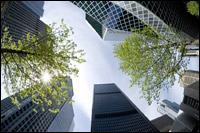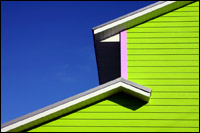This piece is excerpted from the essay “LEED Is Broken; Let’s Fix It.” The full essay can be found here.

Pan of green gables.
Once the narrow province of hippies in beads and Birkenstocks, the green-building world has in the last five years blossomed and taken on a professional sheen. That’s thanks in large part to the U.S. Green Building Council and its flagship program for rating commercial buildings’ environmental performance — LEED, or Leadership in Energy and Environmental Design.
“Green building” was once all in the eye of the claimant, but LEED changed that, creating a national standard for green buildings where none existed before, meeting pent-up demand for reliable information with a rigorous rating system and a checklist for going green. The USGBC has been enormously successful at publicizing the need for, and benefits of, greener buildings. Interest in green building is exploding, with some municipalities, states, and corporations adopting LEED as a standard. Thanks to the USGBC and LEED, we now have momentum, media attention, motivated clients, and a broad understanding of green building.
LEED is a design process that should, in theory, produce buildings that conserve resources, reduce operating costs and pollution, help address global warming, improve marketability and durability, preserve the ozone layer, protect occupant health, and improve worker productivity. When the program was launched, the hope was that it would transform the design and construction of commercial buildings.
But LEED’s early bloom is fading. Green building has a robust future, but this certification system may not. LEED is broken.
The program’s results thus far have been sorely disappointing. Since 2000, LEED has certified only 285 buildings. By contrast, over the same time period, the U.S. Department of Energy’s Building America program helped builders design and erect more than 20,000 new homes, with a minimum 30 percent reduction in energy use for heating, cooling, and hot water at no net cost.
We’re concerned that LEED has become expensive, slow, confusing, and unwieldy, a death march for applicants administered by a soviet-style bureaucracy that makes green building more difficult than it needs to be. The result:
- mediocre “green” buildings where certification, not environmental responsibility, is the primary goal;
- a few super-high-level eco-structures built by ultra-motivated (and wealthy) owners that stand like the Taj Mahal as beacons of impossibility;
- an explosion of LEED-accredited architects and engineers chasing lots of money but designing few buildings; and
- a discouraged cadre of professionals who want to build green, but can’t afford to certify their buildings.
An avalanche of reports insist that green building — and LEED certification in particular — doesn’t cost more than conventional building. These reports are wrong. The second you start a green-building project, it costs more than conventional construction. In the real world, LEED certification typically adds 1 to 5 percent to the budget. The myth that going green costs nothing is damaging to clients who discover the reality deep into the process. Instead of using fuzzy math to show that green building doesn’t add costs, let’s acknowledge that these buildings cost more and are worth it.
The danger is that LEED certification will cannibalize funds that otherwise could be used to improve a building. Developers face a choice: pursue LEED — or purchase a photovoltaic system, daylighting, or efficiency upgrades.
Chris Field, director of the Carnegie Institution’s Department of Global Ecology, which recently built a new facility on the campus of Stanford University, said, “We decided we would rather take money required for LEED certification and spend it on other sustainability features. … [I]nvesting in LEED certification would have meant that we wouldn’t have been able to invest in heat-rejecting windows.”
Milwaukee’s new Urban Ecology Center is one of the greenest buildings in the upper Midwest. Certified? No, “because it could have added as much as $75,000 to the cost, just for the paperwork,” said Ken Leinbach, the center’s executive director.
In LEED, you need 26 of 69 possible points to get certified, and all points are weighted equally, even though some have far greater environmental benefits than others.
Point-mongering is what happens when a design team becomes obsessively focused on getting credits, regardless of whether they add environmental value. And “LEED brain” is a term for what happens when the potential PR benefits of certification begin driving the design process. Unfortunately, if you know how to scam LEED points, you can get the PR benefits without doing much at all (other than mountains of paperwork) to make a project green.
A perfect example of LEED brain comes from Boulder, Colo., where a recreation center received one point for installing an electric-vehicle recharging station. Only problem: there are about six electric vehicles in Boulder that could be charged at that site, and the charging station gets used less than once a year.
Said a respondent to a 2004 survey on LEED conducted by the Green Building Alliance, “In a recent building, we received one point for spending an extra $1.3 million for a heat-recovery system that will save about $500,000 in energy costs per year. We also got one point for installing a $395 bicycle rack.” While this is an extreme case, it points to a real problem: Why install new HVAC equipment for a few extra points when you could get the same points by changing the color of your shingles at no cost?
One solution would be to make more critical credits mandatory. That way, credit-mongering would be played with the cheap cards like low-VOC paints or sealants, not the face cards like energy and water conservation and sustainably harvested wood.
LEED credit reviews feel like Navy SEAL boot camp, where the goal is to fail as many applicants as possible. The reviews are humorless, severe, even confrontational. Green building is hard, and the USGBC should be aiding and abetting green projects, not crushing them with a faceless technocracy.
“The review process is heavy-handed,” noted another respondent to the Green Building Alliance survey. “It’s as if the review contractors are trying to impress the USGBC with their thoroughness and nitpicking. … Review comments are brief and impersonal, without the slightest hint of support.”
Credit interpretations should be constructive, not imply that the applicant is a criminal violating parole. Better yet, instead of our FedExing 30 pounds of old-growth to Washington, D.C., then enduring months of electronic quibbling and water torture, why don’t the LEED evaluators come out and spend a few days looking at a project themselves? They can personally verify the dual-flush toilets, examine the HVAC controls, meet the design team. If there are questions, they could be resolved on the spot.
The review process needs to be dramatically streamlined, and injected with a serious dose of humility and humanity. USGBC consulting engineers are well-trained and should be given more discretion and some latitude for subjective decision making. Does an application meet the spirit of the credit? If so, allocate the point.
For example, LEED awards one point for providing employees in non-perimeter areas the ability to control temperature, air flow, and lighting. We did one better while working on the Snowmass Golf Clubhouse in Aspen, designing it so that there were no non-perimeter workspaces, thus providing every employee with access to views, daylight, and fresh air. But by eliminating non-perimeter workspaces, we didn’t get extra credit; we lost our shot at the credit entirely.
The idea behind LEED is laudable. The execution, so far, has been disappointing. In the final analysis, the world needs green buildings a lot more than green buildings need LEED certification. If LEED continues to cost too much in dollars, time, and effort, we are not going to stop building green projects, we’ll just stop certifying them.
We need green building to triumph, to take over our culture like computers did. We need LEED — or something like it — to accelerate that transition. Let’s roll up our sleeves, get to work, and reinvent LEED — for our future, for our children, and for our planet.



